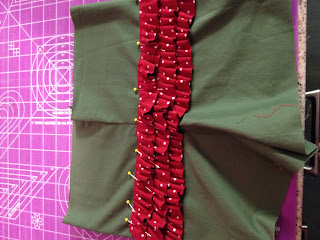I have fallen in love with sewing with knits! I can't seem to get enough of knits. This afternoon I went to JoAnn's and could not leave without at least one knit in hand! With a grandmother and mom who were avid sewers/quilters I can't tell you what age I learned to sew. I always remember having a needle in my hand, but I really began to perfect the art of sewing after my first daughter was born seven years ago.
I remember finding some adorable knit material on sale at Wal-Mart for $1 a yard and probably bought 5 yards. I cut out my pattern and started to piece it together, but the material stretched all over the place. I was frustrated and remember wanting to swear at the machine and threw everything away. Luckily I kept the uncut knit. As I was cleaning out material (Yes, I have to admit that I am a fabric hoarder!) I found the knit. I knew exactly what I wanted to make. One of my first pins on Pinterst was a Razor Back Knit Dress, by Crafter Hours, which is perfect because I was definitely crafting after hours on this one! I was so excited because the blog includes a tutorial and a PDF version of the pattern for sized 12 months to 8 years. I made both girls the dress and they love them. It is lightweight and so comfortable. I am almost tempted to make several and use them as nightgowns or bathing suit cover-ups.
I learned a lot while sewing these dresses together and thought I would share my journey along with a few tips that I have learned from sewing with knits.
Since the pattern is a free PDF download, you have to print the pattern and cut out the pieces and tape them together. This seems like a hassle, but each piece was marked and lined up perfectly. I used double-sided tape to make the process go quicker. I printed two copies of the pattern so that I didn't have to try to cut around the other sizes to get the 12-18 month size. (Something I do with a regular pattern printed on tracing paper.)

When pinning the paper on the knit everything kept sliding. I was beginning to get frustrated again and had flashbacks of the last time I attempted knit. To prevent everything from stretching out before I even began I placed my pins in the material against the stretch of the material. That way my needle didn't keep pulling the knit.
Of course I had to monogram the girls' initials on the dresses. I hate to hoop knit material because it leaves the burn marks where the hoop sat. Instead I place pins all the way around the design. I start with one on the top and bottom, then left and right and then place the corners. This keeps it from slipping off center and me not realizing until the last minute. When embroidering knits be sure to use a good stabilizer. I like to use a mesh or thick cut away. Never use a tear away! The knit is just not stable enough to handle it.

To keep the knit from stretching while sewing on the machine you can use a walking foot. My Bernina has a built in walking foot that straddles the regular foot to help the material move on both sides. I could really tell a difference with the walking foot engaged. If you don't have a walking foot, or it is a hassle to use, you can lift the pressure of your foot. Most machines are set to a default setting that is too snug for knit and it doesn't allow the material to glide through like cotton does. Check the setting. I love my Bernina 830 because it has an auto adjustable foot and it releases the material if it senses too much pressure.

It also helps if you have a knit stitch on your machine. My machine has a crazy looking zigzag that allows the thread to stretch with the knit. Some machines have what is called a jersey stitch that does the same thing.

If you don't have a jersey stitch, you are in luck! You can easily set a zigzag stitch to allow for stretch. I set my width at 2.0 and my length at 2.6. I think I liked this just as much, if not better, than the stretch stitch. The jersey stitch was tighter than I liked and it seemed to pull the material too much through the machine, but it wasn't noticeable in the end product. (I think it is supposed to do this, but I felt like I was messing up the dress while stitching.)
You can also use a serger to sew knits. I really liked using the machine for this project. I always feel like I have more control on my machine versus my serger. The seam also looked a lot less irritable on the machine than having the looped thread from the serger. After attaching the ribbing I trimmed all seams to an eighth of an inch.

Another part I dread about knits is applying the ribbing. The walking foot made this step so much easier. Once I tacked on the ribbing with the first few stitches I was able to stretch the material out as I sewed. Be sure to keep the dress material from stretching, you only want the ribbing to have a slight stretch to it. Don't pull it too hard.

I did add an additional ruffle on to the bottom of the skirt. I just sewed about 2x the length of bottom of the dress together. I made the ruffle about 1.5" wide. Since knit does not fray this ruffle was fairly easy. I ran a gathering stitch down the center of the strip and gathered it up.
I pinned it on to the hem of the dress. It really helps if you use LOTS of pins. I place them about 2-3" apart. I am the type that likes to skip steps along the way to help hurry the dress along. This is a step that you do not want to skip!!! I also skipped actually turning under the hem on the larger dress and that was a big mistake. I am going to have to remove the ruffle and make a hem and place the ruffle back. The ruffle apparently needs something stable to sit against. Since I trimmed the underside after attaching the trim, the trim just folded on itself. This might be too confusing to put into words, but bottom line, it looked bad! The smaller dress I did I actually hemmed the dress according to the directions and then added the ruffle. The bottom of the ruffle went just a hair past the hem of the dress.









































